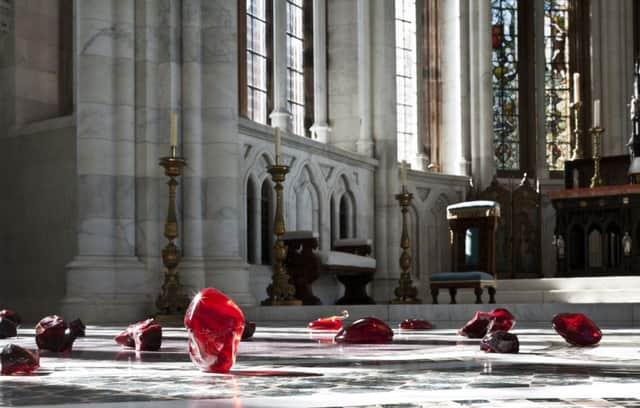Women take charge in art world in 2013


There are two images I can’t get out of my mind from 2013. Both, as it turns out, involve household textiles. The first took place in the sunlit glitz of the Venice Biennale where Cathy Wilkes’s installation in the exhibition, the Encyclopedic Palace, felt like a punch to the guts – in a good way if that’s possible.
Behind what looked like a washing line of ragged but beautiful flower-printed fabric, her sculptural tableau told a melancholy story. There was a figure of a man bent double, his back turned to tiny mute children. Scattered on the floor were worn textiles, shards of pottery and empty bottles. This was a Victorian melodrama of poverty, masculinity and the lure of alcohol, retold for the here and now.
Advertisement
Hide AdThe second is an image fresh from a few weeks ago: Turner Prize winner Laure Prouvost in Derry. She made her acceptance speech wrapped in a tea towel that had been created as part of her residency at Grizedale Arts in Cumbria. While Prouvost spoke the actress Saoirse Ronan held the artist’s new baby Celeste.
In both cases something has long been stirring: the Neanderthal gender politics of the art world are shifting with the generations.
I would be a liar if I said that I thought for even a second that Prouvost would win. Female Turner winners are historically scarce commodities. Her funny, seductive film and installation, Wantee, played on fact and fiction, on the slippery question of authorship and art in the age of the selfie. But Prouvost’s subject, her fictional granddad, a conceptual artist apparently last seen disappearing through a hole in the floor of his own making, stood also for generations of heroic male artists, the strange ancestors of the contemporary art world.
This year felt like a significant one for women in visual arts. My two favourite shows on home ground this year were both by women working in sculpture. Returning home to Scotland Lucy Skaer produced a belter of a show, A Proposal for Mount Stuart, playing with the ornate stagey setting of the stately home on the Isle of Bute. Proving herself unafraid, Skaer dug around in the garden and found broken marble, hewed, wind-fallen trees and created floor-based glass sculpture that made the house’s chapel lantern appear as though it were melting.
New Yorker Carol Bove created an elegant and precise show at the Common Guild reworking a mammoth project for a domestic scale. Everything, from the rust flakes on the floor – from an old oil drum – to the elegantly placed seashells added up to rich mythological stew. Her wonderful show title, The Foamy Saliva of a Horse, took the esoteric (and well researched) biscuit.
At the close of the year (you can still see them now) two sister shows of the late Louise Bourgeois at the Scottish National Gallery of Modern Art and the Fruitmarket provided historical heft.
Advertisement
Hide AdAs some bigger institutions felt increasingly moribund, smaller, fleeter-of-foot galleries have been the key. Kate Gray took Collective Gallery up Calton Hill. It is currently perched in a portakabin next to the City Observatory, which will become a new permanent home. The Glasgow Women’s Library, which is a place for artists as much as readers and writers, moved to a new home in Bridgeton. And thinking of books, a marvelous new biography of the painter Joan Eardley by Christopher Andreae was finally able to say out loud what most had known for years about her long love affair with another woman.
Women are increasingly in charge of the bigger beasts too. After a tricky reception during her settling-in period, the director of Tate Britain, Glasgow-reared Penelope Curtis, this year delivered a refurbishment of the monumental building squatting on the embankment that met with huge acclaim. It featured a vast ceiling drawing by Edinburgh’s Alan Johnston and a new stained glass window by Glasgow’s Richard Wright.
Advertisement
Hide AdAmongst younger artists, print maker Ciara Phillips went from strength to strength and Laura Aldridge excited. It was the film-maker Rachel Maclean who thrilled me most, though, with her bonkers film on the independence debate, The Lion and the Unicorn. Maclean, who to date has starred in all her own films under thick make-up and thicker costumes, is a star in the making. She received this year’s Margaret Tait award.
This is not to say that I didn’t see men doing some great work this year, or that I spend my entire life looking at art from behind engendered spectacles. Nick Evans’ show at Tramway, in particular, was a wonderful showcase for a funny, sophisticated sculptor.
The two blockbusters of the year were both by male painters: the first by Peter Doig was undoubtedly the big budget show of the year in Scotland. Do I need to remind you how much I loathed the Jack Vettriano show at Kelvingrove? (Go on, read it again). It provided me with the liveliest (and largely most supportive) postbag I’ve had for a long time.
Of course not everyone agreed with me. The furore reminded my why I love being a critic, why opinion matters and how important it is we maintain public space for grown up discussions about culture. Invited to give a lecture to university students on the critic’s role I did so against a rolling backdrop of a selection of responses to my review. In order to be discreet I anonymised them all so my audience wouldn’t know who among them was a famous artist and who was an angry troll. They could probably guess though. It was only when I got home I realised I forgot to asterisk out all the offending C words.